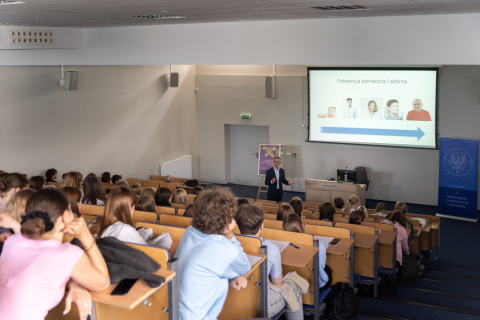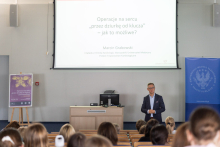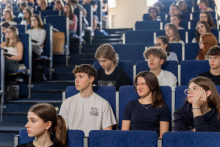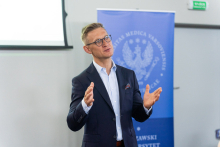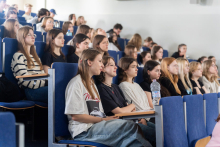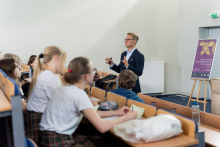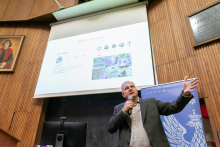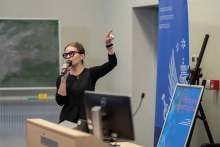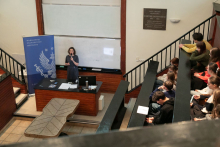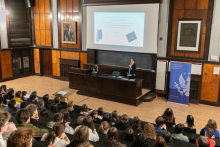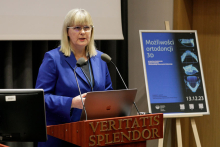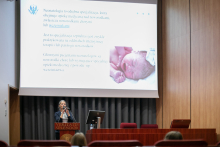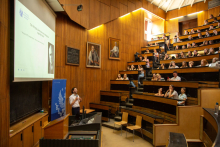Professor Grabowski presented state-of-the-art treatments, procedures and devices that cardiologists use to treat patients.
Minimal punctures - maximum results
- We cardiologists, unlike cardiac surgeons, do not open the chest. We puncture veins, arteries, use various types of catheters, and that's how we get to the heart, where we perform procedures. I call them keyhole procedures because the punctures we perform are really minimal. The patient doesn't even see the wound, and doesn't have to have any sutures - the professor stressed.
Procedure availability code
Importantly, the modern methods that were the subject of the lecture are overwhelmingly already available in Poland. The professor marked each of them with a symbol referring to a traffic light. A green light meant that we are dealing with a procedure available and reimbursed in Poland, a yellow light - available but not reimbursed, and a red light signaled that the procedure is known, but has not yet been performed in our country. It is noteworthy that of the more than a dozen modern methods that the professor discussed, only one received a red light.
- This means that we are absolutely at the forefront of the world when it comes to using innovative procedures and equipment - the speaker noted.
Monitoring equipment
To better explain in which situations the latest techniques are applicable, the professor presented them in conjunction with exemplary patients:
- Let's assume that we have a forty-year-old man who has periodic arrhythmias. To such a patient, we can implant an arrhythmia monitor in the pre-cardiac (fourth intercostal) region. The procedure takes a minute and a half. We inject a plaque through a tiny incision, which monitors every heartbeat for 3-4 years. If the device detects a rhythm disturbance, it will immediately make a diagnosis - what kind of disturbance it is. And if it turns out to be dangerous, the device will communicate with a tracker, and the tracker with our monitoring center.
Image analysis
Professor Grabowski also spoke about modern imaging modalities:
- With coronary angiography, we can use image analysis methods to see the structure of the atherosclerotic plaque. As a result, we can assess which lesions pose an immediate threat and require immediate treatment, and which are stable and do not require urgent intervention.
Innovative systems
Innovations in cardiology are not only treatments, but also certain systems, such as KOS-myocardial infarction, which is a program of one-year comprehensive specialized cardiac care in the following areas: inpatient, outpatient and rehabilitation for patients after a myocardial infarction. As part of the KOS-myocardial infarction program, you can also get an app that improves patient compliance with therapy.
Pacemakers and defibrillators
Professor Grabowski discussed many more modern solutions for those suffering from cardiac arrhythmias - such as pacemakers that lower blood pressure at the same time, or pacemakers that are 1.5 cm long (much smaller than traditional ones). For dangerous arrhythmias, small subcutaneous defibrillators can also be used. Defibrillation vests for people with an increased risk of sudden cardiac death are also a modern solution.
Valve surgeries
The lecture also talked about innovations in the valve treatment.
- For mitral valve regurgitation, a clip is inserted through the catheter, which grasps the two valve leaflets and corrects the regurgitation. With aortic valve stenosis - also without opening the chest - a balloon is inserted to expand the valve, and then a special scaffold is placed to prevent stenosis - the professor explained.
Finally, there was a question-and-answer session. The high school students were curious about, among other things, how long Prof. Grabowski had to study before he performed his first surgery and whether applications that monitor vital signs are reliable.
The meeting was attended by students from: VIII Władysław IV High School, XXVII Tadeusz Czacki High School, XL Stefan Żeromski High School with Bilingual Branches.
In the just-concluded edition of the MUW Patronage Program the lectures were given by:
- Dr. Wiktor Paskal, Department of Research Methodology - What is Plastic Surgery?
- Dr. Beata Borek-Dzięcioł, Department of Neonatology - Neonatology
- Ewa Czochrowska, MD, PhD, Department of Orthodontics - Possibilities of 3D orthodontics
- Dr. Karolina Grąt, 2nd Department of Clinical Radiology - Radiology
- Dr. Antonina Doroszewska, Study of Medical Communication - Difficult conversations with patients
- Prof. Magdalena Kucia, Department of Regenerative Medicine - Regenerative Medicine
- Prof. Artur Ludwin, 1st Department of Obstetrics and Gynecology - How to become a virtuoso of gynecological keyhole surgery?
- Prof. Marcin Grabowski, 1st Chair and Department of Cardiology MUW- Heart surgery “through the keyhole” - how is it possible?
